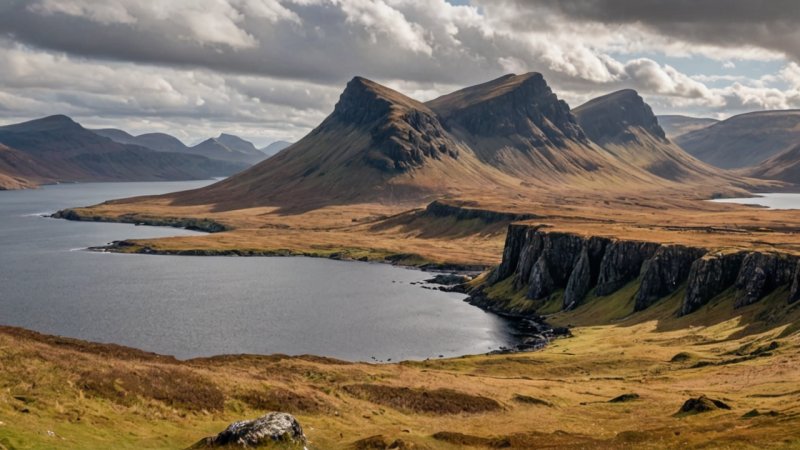Scotland is renowned for its breathtaking landscapes, rich history, and diverse wildlife. Among its most famous destinations are the Isle of Skye and the Scottish Highlands, each offering unique experiences that capture the heart and imagination of travelers. While both regions boast spectacular scenery, they differ significantly in terms of accessibility, attractions, and cultural experiences. In this article, we will explore the pros and cons of visiting the Isle of Skye compared to the Scottish Highlands, helping you decide which destination fits your travel style best.
Geographical Overview
The Isle of Skye, located off the northwest coast of Scotland, is the largest island in the Inner Hebrides. Known for its rugged landscapes, the island features dramatic cliffs, rolling hills, and picturesque villages. In contrast, the Scottish Highlands span a vast area of mainland Scotland, characterized by towering mountains, deep lochs, and expansive glens. The Highlands encompass several different regions, each with its own distinct charm.
Accessibility
One of the significant factors to consider when choosing between these two destinations is accessibility.
- Isle of Skye: The Isle of Skye is accessible via the Skye Bridge from the mainland, making it a relatively straightforward trip. However, public transportation options are limited, and a car is recommended for those wishing to explore the island fully.
- Scottish Highlands: The Highlands are accessible from several major cities such as Inverness and Fort William, with good public transport links. The extensive road network allows travelers to explore various parts of the Highlands without a car, although having one provides more flexibility.
Overall, while the Isle of Skye requires more planning in terms of transportation, the Highlands offer a wider range of access points.
Attractions and Activities
Both the Isle of Skye and the Scottish Highlands are rich in attractions and activities, but they cater to different interests.
- Isle of Skye: Known for its stunning natural landmarks, Skye is home to the iconic Old Man of Storr, the Quiraing, and the Fairy Pools. Outdoor enthusiasts can hike, kayak, or simply enjoy the scenic drives. Additionally, the island has a rich cultural heritage, with historic sites such as Dunvegan Castle.
- Scottish Highlands: The Highlands offer a diverse range of attractions, including Loch Ness, Ben Nevis (the UK’s highest peak), and numerous castles. The region is also famous for its whisky distilleries, providing opportunities for tours and tastings. Outdoor activities like hiking, mountain biking, and skiing in winter are popular.
In summary, if you prefer dramatic landscapes and a more intimate experience, the Isle of Skye may be your best bet. In contrast, if you seek a broader range of activities and attractions, the Highlands could be more appealing.
Cultural Experiences
Cultural immersion is another vital aspect of travel, and both destinations offer unique experiences.
- Isle of Skye: The island is steeped in Gaelic culture, with traditional music and dance prevalent in local gatherings. Visitors can experience this culture through festivals, ceilidhs, and local crafts. The island is also less commercialized, allowing for a more authentic experience.
- Scottish Highlands: The Highlands boast a rich tapestry of history, from ancient clans to the Jacobite uprisings. Visitors can explore various museums and historical sites that recount these tales. Additionally, the Highlands are home to several vibrant towns, like Inverness and Fort William, which offer a bustling atmosphere with shops, eateries, and nightlife.
Ultimately, if you seek a deeper connection with traditional Scottish culture, the Isle of Skye might be ideal. However, for those interested in exploring a broader historical context, the Scottish Highlands provide a wealth of opportunities.
Accommodations and Amenities
When considering a trip, accommodations play a significant role in your overall experience.
- Isle of Skye: Skye offers a range of accommodations, from charming bed and breakfasts to luxury hotels. However, due to its popularity, especially in summer, booking in advance is crucial. Amenities may be limited in more remote areas, but the scenic views often compensate for this.
- Scottish Highlands: The Highlands feature a broader selection of accommodations, including hotels, hostels, and campsites. Major towns like Fort William and Inverness offer more dining and entertainment options, making it easier to find amenities that suit your needs.
In conclusion, if you prefer a more intimate setting with stunning views, Skye is appealing. On the other hand, if you seek variety and convenience, the Highlands are likely a better choice.
Weather Considerations
Scotland is known for its unpredictable weather, so understanding the climate of each destination is essential.
- Isle of Skye: Skye experiences a maritime climate, resulting in mild temperatures but frequent rain. Summer is the most popular time to visit, with longer daylight hours and relatively warmer weather. However, be prepared for sudden showers.
- Scottish Highlands: The Highlands have a more continental climate, with colder winters and warmer summers compared to Skye. Rain is common year-round, and snow can impact travel during winter months. Late spring and early autumn are ideal times to visit for pleasant weather and fewer crowds.
In summary, the Isle of Skye is best visited in summer for its mild climate, while the Highlands can be enjoyed in late spring or early autumn for comfortable weather.
Conclusion
In comparing the Isle of Skye and the Scottish Highlands, it is clear that each destination offers its own unique set of advantages and experiences. The Isle of Skye stands out for its dramatic landscapes and intimate cultural experiences, making it ideal for those seeking a scenic escape. In contrast, the Scottish Highlands provide a broader range of attractions, activities, and amenities, appealing to adventurous travelers looking for diverse experiences. Ultimately, your choice between these two stunning regions will depend on your personal interests, travel style, and the type of experience you seek in Scotland.






